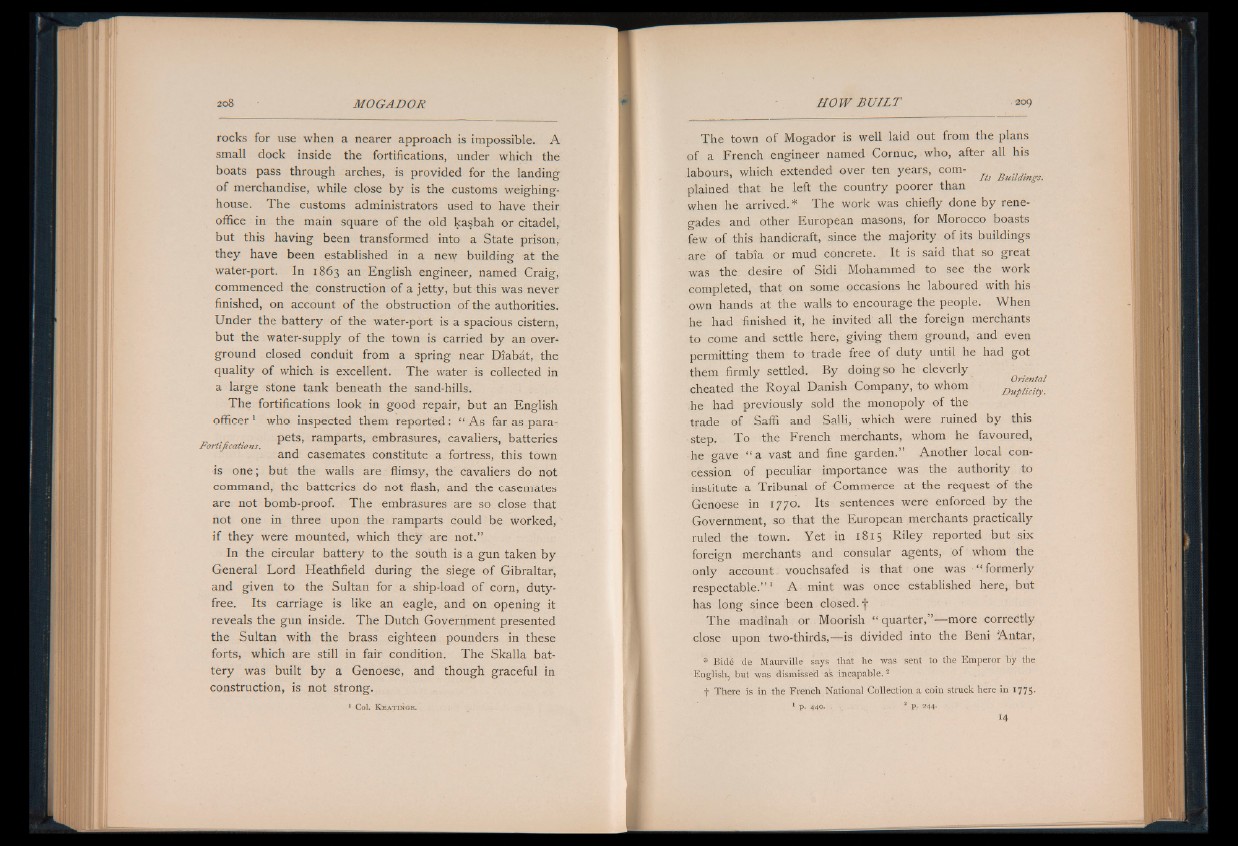
rocks for use when a nearer approach is impossible. A
small dock inside the fortifications, under which the
boats pass through arches, is provided for the landing
of merchandise, while close by is the customs weighing-
house. The customs administrators used to have their
office in the main square of the old kasbah or citadel,
but this having been transformed into a State prison,
they have been established in a new building at the
water-port. In 1863 an English engineer, named Craig,
commenced the construction of a jetty, but this was never
finished, on account of the obstruction of the authorities.
Under the battery o f the water-port is a spacious cistern,
but the water-supply o f the town is carried by an overground
closed conduit from a spring near Diabat, the
quality of which is excellent. The water is collected in
a large stone tank beneath the sand-hills.
The fortifications look in good repair, but an English
officer 1 who inspected them reported: “ A s far as para-
’. . pets, ramparts, embrasures, cavaliers, batteries
rortiftcatio ns.
and casemates constitute a fortress, this town
is one; but the walls are flimsy, the cavaliers do not
command, the batteries do not flash, and the casemates
are not bomb-proof. The embrasures are so close that
not one in three upon the ramparts could be worked,
if they were mounted, which they are not.”
In the circular battery to the south is a gun taken by
General Lord Heathfield during the siege o f Gibraltar,
and given to the Sultan for a ship-load of corn, dutyfree.
Its carriage is like an eagle, and on opening it
reveals the gun inside. The Dutch Government presented
the Sultan with the brass eighteen pounders in these
forts, which are still in fair condition. The Skalla battery
was built by a Genoese, and though graceful in
construction, is not strong.
1 C o l . K e a t i n g e .
The town o f Mogador is well laid out from the plans
of a French engineer named Cornuc, who, after all his
labours, which extended over ten years, com- „
plained that he left the country poorer than
when he arrived. * The work was chiefly done by renegades
and other European masons, for Morocco boasts
few of this handicraft, since the majority of its buildings
are of tabia or mud concrete. It is said that so great
was the desire of Sidi Mohammed to see the work
completed, that on some occasions he laboured with his
own hands at the walls to encourage the people. When
he had finished it, he invited all the foreign merchants
to come and settle here, giving them ground, and even
permitting them to trade free of duty until he had got
them firmly settled. By doing so he cleverly ■
Onentat
cheated the Royal Danish Company, to whom Duplicity.
he had previously sold the monopoly of the
trade of Saffi and Salli, which were ruined by this
step. To the French merchants, whom he favoured,
he gave “ a vast and fine garden.” Another local concession
of peculiar importance was the authority to
institute a Tribunal of Commerce at the request of the
Genoese in 1770. Its sentences were enforced by the
Government, so that the European merchants practically
ruled the town. Yet in 1815 Riley reported but six
foreign merchants and consular agents, of whom the
only account vouchsafed is that one was “ formerly
respectable.” 1 A mint was once established here, but
has long since been closed, f
The madinah or Moorish “ quarter,”— more correctly
close upon two-thirds,— is divided into the Beni Antar,
I Bid6 de Maurville says that he was sent to the Emperor by the
English, but was dismissed afc incapable.2
f There is in the French National Collection a coin struck here in 1775.
1 p . 4 4 0 . t . 2 p . 2 4 4 -